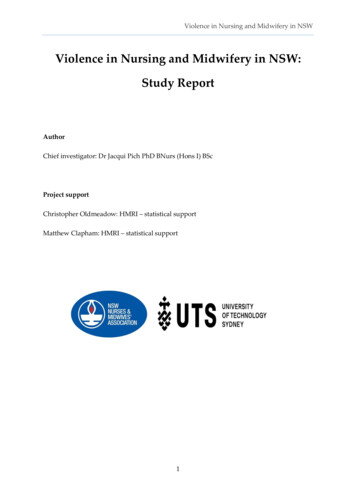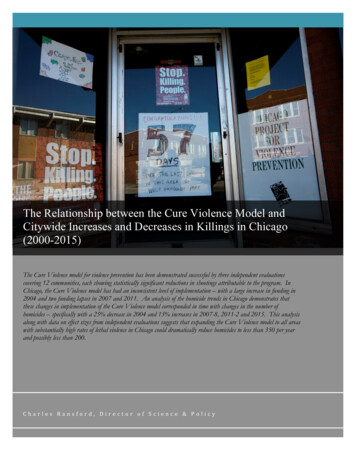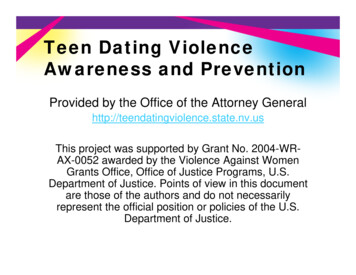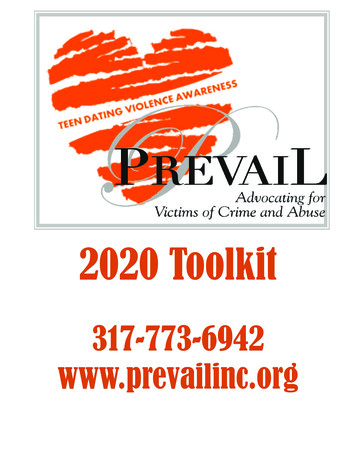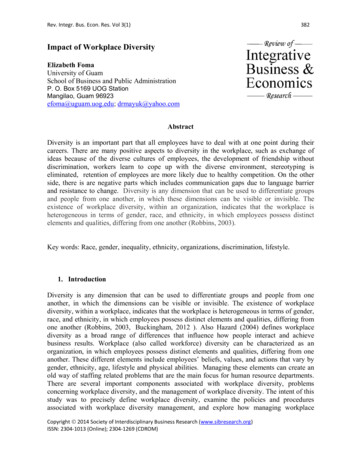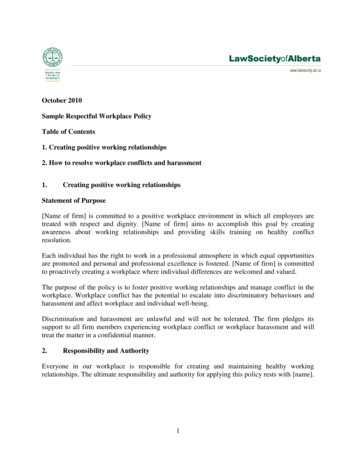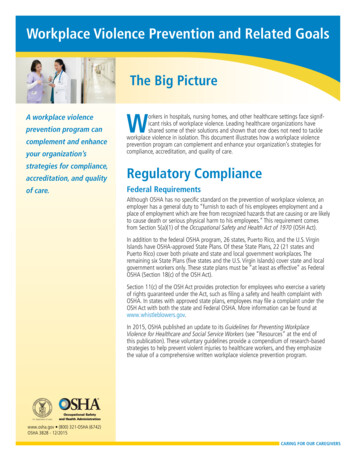
Transcription
Workplace Violence Prevention and Related GoalsThe Big PictureA workplace violenceprevention program cancomplement and enhanceyour organization’sstrategies for compliance,Workers in hospitals, nursing homes, and other healthcare settings face significant risks of workplace violence. Leading healthcare organizations haveshared some of their solutions and shown that one does not need to tackleworkplace violence in isolation. This document illustrates how a workplace violenceprevention program can complement and enhance your organization’s strategies forcompliance, accreditation, and quality of care.accreditation, and qualityRegulatory Complianceof care.Federal RequirementsAlthough OSHA has no specific standard on the prevention of workplace violence, anemployer has a general duty to “furnish to each of his employees employment and aplace of employment which are free from recognized hazards that are causing or are likelyto cause death or serious physical harm to his employees.” This requirement comesfrom Section 5(a)(1) of the Occupational Safety and Health Act of 1970 (OSH Act).In addition to the federal OSHA program, 26 states, Puerto Rico, and the U.S. VirginIslands have OSHA-approved State Plans. Of these State Plans, 22 (21 states andPuerto Rico) cover both private and state and local government workplaces. Theremaining six State Plans (five states and the U.S. Virgin Islands) cover state and localgovernment workers only. These state plans must be “at least as effective” as FederalOSHA (Section 18(c) of the OSH Act).Section 11(c) of the OSH Act provides protection for employees who exercise a varietyof rights guaranteed under the Act, such as filing a safety and health complaint withOSHA. In states with approved state plans, employees may file a complaint under theOSH Act with both the state and Federal OSHA. More information can be found atwww.whistleblowers.gov.In 2015, OSHA published an update to its Guidelines for Preventing WorkplaceViolence for Healthcare and Social Service Workers (see “Resources” at the end ofthis publication). These voluntary guidelines provide a compendium of research-basedstrategies to help prevent violent injuries to healthcare workers, and they emphasizethe value of a comprehensive written workplace violence prevention program.U.S. Department of Laborwww.osha.gov (800) 321-OSHA (6742)OSHA 3828 - 12/2015CARING FOR OUR CAREGIVERS
State RequirementsAs of August 2015, nine states require certain healthcare facilities to have some type of workplace violence prevention program. As these requirements are established by state law, they are enforced by the states and not by OSHA.In 1993, California became the first state to require healthcare facilities to develop and maintain a violence prevention program. Subsequent statelaws incorporated elements of the initial California state law. Currently, California is working on updating state requirements.The requirements in these states differ. State laws in California, Washington, New York, New Jersey, and Connecticut require healthcare employersto provide comprehensive workplace violence prevention programs. In New York, the law applies to public workplaces but not to the privatesector. In the other states, laws are directed toward specific healthcare settings such as acute psychiatric care, long-term and residential care, orambulatory surgical centers. States with workplace violence prevention legislation can be models for other states that are considering their ownlegislation.Washington (Title 49, Chapter 49.19)Who is covered: Hospitals, home health, hospice, home care agencies,community mental health programs, and evaluation and treatment facilitiesPenalties for perpetrators: YesWashington’s law requires facilities to perform a hazard assessment andrecord review, then develop a violence prevention plan. Training mustbe provided regularly to all affected employees identified in the violenceprevention plan, and it must occur within 90 days of an employee’s startdate. Records must be available for incidents occurring during the last fiveyears.Oregon (2013 ORS, Vol. 14, Chapter 654)Who is covered: Hospitals, ambulatory surgical centers, and homehealthcare servicesPenalties for perpetrators: NoOregon’s law requires periodic hazard assessments and recordreviews, which must feed into a violence prevention plan. Theplan must take into account the physical attributes of the facility,staffing, personnel policies, first-aid and emergency procedures,reporting of violent acts, and employee education and training.Employees have the right not to treat a patient who has assaultedthem if the employer denies the employee’s request to have asecond employee present. An employee in home healthcare mayrefuse to treat a patient unless the employer provides the employeewith a two-way communication device. Training must occur within90 days of an employee’s start date and is provided as neededthereafter. Records must be kept for five years.Illinois (405 ILCS 90/)Who is covered: Mental health and developmental disabilityfacilitiesPenalties for perpetrators: YesIllinois’ law requires a violence prevention plan to beimplemented based on findings from a risk assessment andrecord review. The plan must be reviewed at least once everythree years and must take into account the facility’s physicallayout, personnel policies, first-aid and emergency procedures,reporting of violent acts, and employee education and training.All affected employees must be trained within 90 days of theirstart date, and they must receive periodic refresher training. Thefacility must keep records of workplace violence incidents.California (State Health and Safety Code and SB-1299)Who is covered: General acute care, acute psychiatric, and certain other types of hospitalsPenalties for perpetrators: YesCalifornia’s law requires a designated committee to develop a safety plan, which must be updated basedon findings from an annual facility assessment. This plan should take into account physical layout, staffing,security personnel, policy and training related to appropriate responses, and coordination with local lawenforcement. Facilities must track incidents of violent behavior and evaluate trends. Affected employees andcollective bargaining agents must be engaged in worksite analysis. Safety and health training is required.Sources: Penalties for perpetrators are based on a review of two sources as of August 2015:o American Nurses Association. Workplace violence. http://nursingworld.org/workplaceviolence.o Emergency Nurses Association. 50 state survey: Criminal laws protecting health professionals. teLawsWorkplaceViolenceSheet.pdf. States are labeled “Yes” if their laws explicitly impose penalties for assaulting a healthcare worker. Oregon is listed as “No” because its law is limited to emergency medical service workers.Altogether, more than 30 states provide some type of penalty for assaulting a healthcare worker. Other information is based on a review of state laws and regulations.22Washington State’s efforts to reduce workplace violence in the healthcare industry have led to lower injury rates and workers’compensation costs. From 1997 to 2007, the state’s average annual rate of workers’ compensation claims associated withworkplace violence in the healthcare and social assistance industry was 75.5 per 10,000 full-time equivalent workers (FTEs).From 2007 to 2013, the rate had fallen to 54.5 claims per 10,000 FTEs—a decrease of 28 percent. This improvementcoincides with Washington’s 2009 rule that required hazard assessments, training, and incident tracking for workplaceviolence.Source: Foley, M., and Rauser, E. 2012. Evaluating progress in reducing workplace violence: Trends in Washington State workers’compensation claims rates, 1997–2007. Work. 42: 67–81. (Updated data provided by the authors in 2015.)New York (Labor Law Article 2)Who is covered: Public facilities with at least 20 full-timepermanent employees, including state-run healthcare andsocial service facilitiesPenalties for perpetrators: YesNew York’s law requires a risk assessment of theworkplace, which includes consideration of hazards suchas working late, working alone, and exchanging money.Each facility must have a violence prevention plan thataddresses the identified hazards. Employees are requiredto complete training at the start of employment andannually thereafter. Each facility must have a system forreporting incidents. Strong requirements for employeeinvolvement have served as a model for other states’ laws.Maine (Sec. 1. 22 MRSA §1832)Who is covered: HospitalsPenalties for perpetrators: NoMaine’s law requires a safety and security planto be implemented annually, and hospitals musthave a process to receive and record incidents orthreats of violent behavior.Connecticut (Public Act No. 11-175)Who is covered: Hospitals, long-term and residential care, behavioralhealth, outpatient and ambulatory care, home care, and otherfacilities with 50 or more full- or part-time employeesPenalties for perpetrators: YesConnecticut’s law requires a workplace safety committee with equalrepresentation among management and employees. The committeemust meet quarterly, conduct an annual risk assessment, andimplement a violence prevention plan. An employee has the right torequest accompaniment when caring for a patient who previouslyassaulted them, or they may ask to be reassigned. Employers mustkeep detailed incident records and must report assaults to authoritieswithin 24 hours (with some exceptions).New Jersey (P.L. 2007, Chapter 236)Who is covered: Hospitals and nursing homesPenalties for perpetrators: YesNew Jersey’s law requires a violence prevention committee to conduct an annual risk assessmentand develop a violence prevention plan. At least half of the committee must be direct caregivers.The assessment must consider the facility’s layout, crime rate in surrounding areas, lighting insurrounding areas, communication and alarm devices, and staffing; it must include a recordsreview and a review of existing policies. The plan must specify risk reduction strategies and mustestablish a post-incident response system. Employees must receive annual training in identifyingprecipitating factors of violence and appropriate responses. Records of violent events must bekept for five years.Maryland (Senate Bill 483)Who is covered: Hospitals, state residential facilities, and nursing homes licensed for 45 beds or morePenalties for perpetrators: NoMaryland’s law requires each facility to conduct an annual assessment and have a workplace safety committee. Hospitals and state residentialfacilities’ committees must have equal representation among management and employees, their employees must receive regular training, andthey must have a system for reporting, responding to, and tracking incidents.3
Workplace Violence Prevention and Related Goals: The Big PictureAccreditationMany healthcare organizations pursue accreditation by an independentaccreditation body, The Joint Commission being the largest. While The JointCommission’s healthcare standards and accreditation process have long focusedon protecting patient safety, many of the standards and management systemsdesigned to ensure patient safety can also be adapted and applied to workersafety. In addition, efforts to improve worker safety often have the result ofimproving patient care. Joint Commission–accredited healthcare organizationsoften already have building blocks in place to reduce workplace violence andother worker safety risks.The Joint Commission’s accreditation manual has several standards related toworkplace violence, spread across four chapters of the manual.1 The manuallists the accreditation requirements specific to workplace violence in differenthealthcare organizations, including hospitals, doctors’ offices, nursing homes,office-based surgery centers, behavioral health treatment facilities, and providersof home care services. Particularly relevant standards include:“The organizational culture, Environment of Care (EC)tools for creating safety are Emergency Management (EM)the same, regardless of the Leadership (LD)population whose safety is Performance Improvement (PI)the focus.”For example, developing a strong safety culture, addressed in Joint CommissionStandard LD.03.01.01 for hospitals (“Leaders create and maintain a cultureof safety and quality throughout the hospital”), is a key aspect of ensuringboth worker and patient safety.2 A strong safety culture includes managingand mitigating the risk of harm as reflected in Standard EC.02.01.01 (“Thehospital manages safety and security risks”). It also includes empoweringstaff to report incidents without fear of reprisal, which is included in StandardLD.04.04.05 (“The hospital has an organization wide, integrated patient safetyprogram within its performance improvement activities”). Reporting enableshealthcare organizations to track and analyze incidents to inform both proactiveand reactive risk reduction. Standard EM.02.02.05, EP 3 (“The EmergencyOperations Plan describes how the hospital will coordinate security activitieswith community security agencies [for example, police, sheriff, National Guard]”)provides another connection, as it requires preparation for emergencies such asan active shooter situation. Although these three examples come from The JointCommission’s hospital standards, safety expectations are also in place for othersettings such as long-term care, ambulatory care, behavioral health, and homecare.341 Joint Commission. 2015. 2015 Comprehensive Accreditation Manual for Hospitals (CAMH). 2015. Oakbrook, IL: Joint Commission Resources.2 Joint Commission. 2015. 2015 Comprehensive Accreditation Manual for Hospitals (CAMH). 2015. Oakbrook, IL: Joint Commission Resources.3 Standards reprinted here with The Joint Commission’s permission.principles, methods, and– The Joint Commission.Improving Patient and WorkerSafety: Opportunities forSynergy, Collaboration andInnovation.
Workplace Violence Prevention and Related Goals: The Big PictureThe Joint Commission’s Improving Patient and Worker Safety: Opportunity for Synergy, Collaboration and Innovation4 highlights additional synergies between patient and worker health and safety activities. To successfully integrate patient andworker safety, the document recommends: Encouraging leaders to make patient and worker safety core organizational values. Identifying opportunities to integrate patient and worker safety activities across departments and programs. Understanding and measuring performance on safety-related issues. Implementing and maintaining successful worker and patient safety improvements.The Joint Commission shares recommendations, policies, procedures, and other information to help facilities prevent workplace violence. For example, it adopted a formal Sentinel Event Policy in 1996 to help hospitals that experience serious eventslearn from those events and implement actions to prevent future events.5 A sentinel event is a patient safety event that resultsin any of the following: death, permanent harm, or severe temporary harm and intervention required to sustain life. In 2014,The Joint Commission added to its list of events considered sentinel: rape, assault (leading to death, permanent harm, orsevere temporary harm), or homicide of a staff member, licensed independent practitioner, visitor, or vendor while on site atthe hospital.6 Reporting a sentinel event to The Joint Commission is optional, but it can provide crucial data to help The JointCommission and others identify causes, track trends, extract lessons learned, and ultimately contribute to better preventionstrategies. The Joint Commission’s sentinel event data collection and analysis processes protect the confidentiality of thepatient, the caregiver, and the hospital.A comparison between broader safety and health management system elements and the elements of performance found inrelated Joint Commission standards can be found in OSHA’s Safety and Health Management Systems and Joint CommissionStandards.7OSHA and The Joint Commission have established an alliance to provide healthcare workers and others in the healthcareindustry with information, guidance, and access to training resources to help protect employees’ health and safety. Freeresources, including many articles, are available at imilar connections between accreditation and worker safety can be found in standards from other accrediting organizations,such as the Healthcare Quality Association on Accreditation (HQAA), Accreditation Association for Ambulatory Health Care(AAAHC), Accreditation Commission for Health Care (ACHC), and Commission on Accreditation of Rehabilitation Facilities(CARF). For example, CARF accredits programs primarily in the areas of aging, behavioral health, substance abuse treatment,and child and youth services. Its Standard 1.H.13 refers to “comprehensive health and safety inspections” conducted bythe external authorities, including OSHA. The standard requires a healthcare facility to submit a written report to CARF thatidentifies health and/or safety areas inspected, issues that were discovered during the inspection, and an action plan forimprovement. The 2015 CARF-CCAC Standards Manual is available for download at bit.ly/1JBpOXD.4J oint Commission. 2012. Improving Patient and Worker Safety: Opportunities for Synergy, Collaboration and Innovation.www.jointcommission.org/improving Patient Worker Safety.5 Joint Commission. 2014. Sentinel event policy and procedures. www.jointcommission.org/Sentinel Event Policy and Procedures/default.aspx.6 Reprinted here with The Joint Commission’s permission.7 OSHA. 2013. Safety and Health Management Systems and Joint Commission Standards. www.osha.gov/dsg/hospitals/documents/2.2 SHMS-JCAHO comparison 508.pdf.5
Workplace Violence Prevention and Related Goals: The Big PicturePatient SafetyIncreasingly, healthcare facilities are integrating their patient safety and workersafety programs and managing them together using a common framework.Doing so makes sense, because many of the risk factors that affect patient safetyalso affect workers. For instance, a violent confrontation or intervention canresult in injuries to both workers and patients, and caregiver fatigue, injury, andstress are tied to a higher risk of medication errors and patient infections.8In addition, the tools used to monitor, manage, and improve patient safety haveproven equally effective when applied to worker safety. For example, if yourfacility is Joint Commission accredited, you may be able to adapt existing compliance monitoring tools and infrastructure to address occupational safety. Severalhospitals use their “environment of care” rounds to monitor for conditions thatcould affect either patient or worker safety.Strategies to improve patient safety and worker safety can go hand-in-hand—particularly those that involve nonviolent de-escalation and alternatives suchas sensory therapy. The nationwide movement toward reducing the use ofrestraints (physical and medication) and seclusion in behavioral health—which ismandated in some states—along with the movement toward “trauma-informedcare,” means that workers are relying more on approaches that result in lessphysical contact with patients, intervening with de-escalation strategies beforean incident turns into a physical assault, preventing self-harm by patients, andultimately equipping patients with coping strategies that can help them for life.The results can be a “win-win” for patient and worker safety.A Culture of SafetyAn organization’s culture is the product of individual and group beliefs, values,attitudes, perceptions, competencies, and patterns of behavior that determinethe organization’s commitment to objectives such as quality and safety. Manyleading healthcare organizations are reducing injuries to both patients andworkers by fostering a “culture of safety” characterized by an atmosphere ofmutual trust, shared perceptions of the importance of safety, confidence in theefficacy of preventive measures, and a no-blame environment. Typical attributesof a culture of safety include: Staff and leaders who value transparency, accountability, and mutual respect Safety as everyone’s first priority Not accepting behaviors that undermine the culture of safety A focus on finding hazardous conditions or “close calls” at early stages beforeinjuries occur An emphasis on reporting errors and learning from mistakes Careful language to facilitate conversation and communicate concerns8Rogers, A.E., Hwang, W.T., and Scott, L.D. 2004. The effects of work breaks on staff nurse performance. Journal of NursingAdministration. 34(11): 512–519.6“Workplace safety is inextricablylinked to patient safety. Unlesscaregivers are given theprotection, respect, and supportthey need, they are more likelyto make errors, fail to follow safepractices, and not work well inteams.”—National Patient SafetyFoundation, Lucian Leape Institute.Through the Eyes of the Workforce:Creating Joy, Meaning, and SaferHealth Care“Safety is safety. We don’tdifferentiate between patientand associate safety. We practiceand encourage safety behaviorsfor both patients and associates.The behaviors we promote areexactly the same.”—Kate Henderson, Vice Presidentand Chief Operating Officer, UMCBrackenridge“Where some hospitalswould limit their approach tomedication, we use a moreholistic approach. We work withpatients as individuals, to findout what has a calming effecton them, and help them put thatinto practice. The result can be apositive change that lasts the restof their lives.”—Cindy Chaplin, RN, BSN, NurseEducator, Massachusetts NursesAssociation Local Unit Chairperson,Workplace Violence Task Force CoChair, Providence Behavioral HealthHospital (Holyoke, Massachusetts)
Workplace Violence Prevention and Related Goals: The Big PictureHigh ReliabilityOrganizations: FiveOperational ProcessesSensitivity to operations:Workers in HROs are mindfulof procedures and interactionsbetween team members. Thisheightened situational awareness sensitizes them to minordeviations and enables them torespond appropriately.Reluctance to simplify:When outcomes deviate fromestablished plans, HROs questionconventional explanations forwhy things went wrong andexplore the entire potential scopeof the problem.Preoccupation with failure:No matter how enviable theirtrack records, HROs never letsuccess breed complacency. Theyfocus unceasingly on ways thesystem can fail, and encouragestaff to always listen to their“inner voice of concern” andshare it with others.Many healthcare organizations have strengthened their cultures of safety byembracing two sets of principles: High reliability organization (HRO) principles arose from air traffic control,nuclear power, and other industries characterized by complex systems withinnate risks that must be managed effectively to avoid catastrophe. The JointCommission has endorsed the use of similar principles to transform healthcareinto a high reliability industry.9 The Joint Commission promotes an environmentof “collective mindfulness” in which employees look for and report smallproblems or unsafe conditions before they pose a substantial risk, and whenthey are easy to fix. The identification and careful analysis of errors can revealweaknesses in protocols or procedures that can be remedied to reduce the riskof future failures. “Just Culture” involves creating an atmosphere of trust, encouraging andrewarding people for providing information on how errors occurred, so thesources of error can be analyzed. This can result in changes that improve safety.As Lucian Leape, MD, explains: “Approaches that focus on punishing individualsinstead of changing systems provide strong incentives for people to report onlythose errors they cannot hide. Thus, a punitive approach shuts off the information that is needed to identify faulty systems and create safer ones. In a punitivesystem, no one learns from their mistakes.”10In hospitals and other healthcare organizations, HRO and “Just Culture” canbenefit both patients and workers, with the goal of improving safety for all.Deference to expertise: Teammembers and organizationalleaders in HROs defer to theperson with the most knowledgerelevant to the issue they areconfronting. This may involvedeviating from the traditionalphysician, nurse, and technicianhierarchy.Example: “Tapping Out”Sometimes a healthcare worker finds him- or herself in a verbal powerstruggle with an agitated patient, or finds that he or she is gettingfrustrated and not making progress. At Providence Behavioral HealthHospital in Holyoke, Massachusetts, other colleagues are encouragedto recognize this type of situation and “tap in” by telling the first workersomething like “You have a phone call—and it’s your supervisor.” Sometimes all it takes is a new face to get a patient to calm down, and theemphasis on caring language allows the first worker to exit the situationgracefully. This type of focus on collaboration and respectful language isa hallmark of a “culture of safety.”Resilience: HROs acknowledgethat, despite considerablesafeguards, errors will sometimesoccur. By anticipating and planning for such situations, they cancontain and minimize the adverseconsequences.9See, for example, , L. 2000. Testimony, United States Congress, United States Senate Subcommittee on Labor, Health and Human Services,and Education. January 25, 2000.107
Example: “Culture of Safety” at Ascension HealthAscension Health is the nation’s largest Catholic and not-for-profit health system, with more than 150,000 employees(associates) at 1,900 locations, including more than 100 hospitals. Although all of these hospitals have dedicated safetyprofessionals available, they cannot be everywhere at all times, nor can they expect to be experts in all the operations of amodern hospital. Recognizing this, several Ascension hospitals have adopted HRO principles to provide all associates withtools, resources, authority, and accountability that make it possible for everyone to integrate associate safety into their dailyactivities, just like they do for patient safety.Key components of Ascension’s program include: Empowering associates Making safety routine and visible Training Management visibility and commitmentFor example, University Medical Center Brackenridge (UMC Brackenridge) in Austin, Texas, provides high reliabilitysafety training to 100 percent of staff and on-site contractors. Safety coaches throughout the hospital receive additionaltraining. Training tools include videos, staff testimonials, and role-playing in an on-site simulation laboratory.At St. Vincent’s Medical Center in Bridgeport, Connecticut, each day begins with a “safety huddle” led by a senior executive. Representatives from all departments, including both clinical and non-clinical services, are required to attend. Togetherthey review any patient or associate safety events or concerns, recognize “good catches” (near-misses), and share updateson the status of safety-related projects or initiatives. These daily exchanges, fostered in an open, no-blame environment, helpcreate an atmosphere of trust and cooperation. Several other Ascension hospitals use a similar approach.Ascension Health’s hospitals teach associates to intervenein situations using the “language of care.” For example,any associate can stop the process by saying “I have aconcern”—akin to the idea that any employee in a factorycan stop the assembly line if he or she sees something wrong.Other examples: It’s not a “near-miss”; it’s a “good catch.” With patients, “We’re doing [x] for your safety.”Additionally, nurses—or even pastoral care staff—may takethe lead in responding to certain security events, in partnership with security staff, so as to keep the focus on caring forthe patient.To remove barriers to reporting, Ascension Health hasadopted computer-based reporting systems that emphasizereporting of “good catches” to provide opportunities toproactively reduce hazards. An associate who reports aconcern will likely be engaged in follow-up discussion, rootcause analysis, and response. Saint Agnes Hospital inBaltimore, Maryland, increased reporting by 75 percent usingthis approach. At UMC Brackenridge, senior administratorsshow their appreciation by writing a thank-you note to anyassociate who makes a “good catch.”8Any UMC Brackenridge associate who makes a“good catch” receives a thank-you note fromthe leadership team.
Workplace Violence Prevention and Related Goals: The Big PictureSafety and Health Management Systems:A Comprehensive ApproachA workplace violence prevention program can fit effectively within a broader safety and health management system, alsoknown as an injury and illness prevention program. Under this type of program, employers and employees continually monitorthe workplace for hazards and then cooperate to find and implement solutions. All of this happens within a Plan-Do-StudyAct management system framework that should be familiar to healthcare administrators. A comprehensive safety and healthmanagement system can effectively manage a wide range of worker safety risks in healthcare, including workplace violence;patient handling (e.g., lifting); bloodborne pathogens; slips, trips, and falls; and more. This approach can go hand-in-hand withHRO principles and practices.Almost all successful safety and health management systems include six core elements that are very similar to the elements ofa workplace violence prevention program:Safety and HealthManagementSystem ElementManagement leadershipOverviewManagers demonstrate their commitment to improved safety andhealth, communicate this commitment, and document safety andhealth performance. The
The Big Picture W orkers in hospitals, nursing homes, and other healthcare settings face signif-icant risks of workplace violence. Leading healthcare organizations have shared some of their solutions and shown that one does not need to tackle workplace violence in isol
